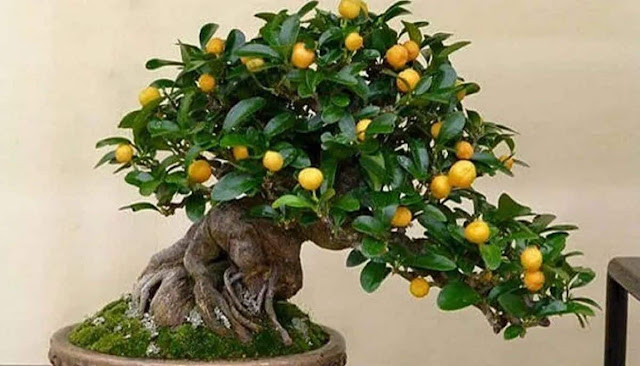Citrus Bonsai: How To Care For Your Tree
Citrus bonsai are evergreen trees native to Asia that are popular on plantations as fruit orchids. These trees produce fragrant white flowers with a greater frequency of small fruits than large ones. When these flowers are pollinated, they produce edible fruits. Citrus trees with small fruits and foliage, such as lemon (Citrus limon) and orange (Citrus sinensis), are ideal for bonsai. However, some cultivars are difficult to manage due to their thorns.
Pets should be kept away from citrus bonsai, as they can injure the tree. If pruned and maintained appropriately, they produce edible fruits with similar qualities and flavors. The most popular orange tree for use as a bonsai is the calamondin orange, which produces small, edible fruits and blooms nearly year-round. Similar in flavor to kumquats, Calamondin oranges are also known as acid oranges in some regions of the United States.
Due to their capacity to withstand temperatures of up to 21 degrees Fahrenheit (-6 degrees Celsius), Calamondin oranges are also popular as bonsai. Although not optimal for outdoor use, they can withstand cold weather for brief periods.
See also: Bonsai Tree That Grows Fruit
Care Guidelines For Citrus Bonsai
Perfect Placement
Sunlight and warmth are ideal for citrus trees. They require at least six hours of sunlight per day. Your citrus bonsai can stay outside all year if you live in a warm region.
Remember that citrus trees flourish around 69-90° Fahrenheit (21-32°C).
In a temperate region, you can keep your tree outside in the spring and summer, but in the fall, you must bring it indoors or into a greenhouse. Most citrus trees don't perform well in temperatures below 55° Fahrenheit (13°C).
You'll need to buy some grow lights if you plan to keep your bonsai tree indoors during the winter and out of the way of sunshine.
If feasible, set your tree in a sunny window without drafts.
Water Requirements
Watering citrus trees is easy. During the growing season, they need regular watering but can handle short periods of drought. Keep your tree watered.
Your bonsai shouldn't be overwatered. Wet soil causes root rot in citrus trees. Examining your soil is the greatest approach to determine when to irrigate.
Put your finger in the soil to check it. If it's dry, water your bonsai. If the soil seems moist, wait another day. The soil should never be completely dry, yet persistent dampness is bad for your plant.
The amount of waterings can be reduced in winter.
Between waterings, let the soil dry out, but don't leave it dry too long.
Acidic environments suit citrus trees. Lime-free water is excellent for wearing this bonsai.
Soil And Fertilizer
A citrus bonsai tree needs particular fertilizer. Liquid and solid versions of this fertilizer are available. If you can't get it, use a normal acid-loving plant fertilizer.
Liquid fertilizer must be applied weekly to bonsai during the growing season. Once a month in winter. To avoid scorching the roots of your plant, make sure it has received adequate watering before applying the fertilizer.
You can fertilize your bonsai once a month during the growing season with solid fertilizer. For three winter months, you can cease fertilizing. After applying fertilizer, properly water your tree.
When using fertilizer on a bonsai, the strength must be regulated.
To minimize excessive growth in your citrus bonsai, use half the suggested strength.
Pruning Times
As soon as a shoot has four leaves, you can trim back new growth. The clipped shoots should have at least two new leaves. If you want results, pruning is crucial.
Only pruning can shape a citrus bonsai.
Pinch back new growth regularly, especially in places you want to shape and style.
If you want fruit, don't remove any buds. Remove fruits from your tree in fall to reduce stress. Your tree needs all its energy to endure winter.
Repotting Times
Depending on the tree's age, citrus bonsai need to be repotted every two or three years. When repotting into a bonsai potting tray for the first time, remove all roots except the main root stem.
Before your tree recovers, keep the soil moist but not damp.
Use mulch like sphagnum moss to cover the soil. You can limit some evaporation while still enabling your soil to drain effectively.
Repotting established bonsai in the spring before new growth emerges is recommended. Do some root pruning and plant your tree in slightly acidic soil. Add peat to your potting mix to acidify the soil. The soil must drain efficiently because citrus trees can't stand in water for long.
Propagation Management
Citrus trees are great for seed propagation since they grow quickly. Citrus seeds are also simple to obtain. Purchase an orange or lemon cultivar and let the fruit ripen. Before the fruit spoils, remove the pulp and harvest the seeds. You may buy seeds too.
You can air layer or take cuttings from your citrus tree. All of these strategies are effective.
Diseases And Pests
Citrus trees are generally pest- and disease-resistant if properly cared for. During stress, your plant may get mealybugs, spider mites, scale, leaf-miner fly larva, or vine weevils.
These pests thrive on trees in warm, dark places.
To treat these pests, acquire a pesticide for that bug or a generic pesticide from your local gardening shop. If you want to avoid harsh chemicals, try vinegar, water, and dish soap or neem oil.
Wiring Bonsai
Citrus bonsai can be wired year-round. Wiring your tree must be done carefully to avoid injuring the bark. Guy wires are recommended for shaping this type of tree.
Pruning is the finest way to shape a tree. New growth is easy to train. Be careful not to break green shoots when bending them. Patience is needed for training.
